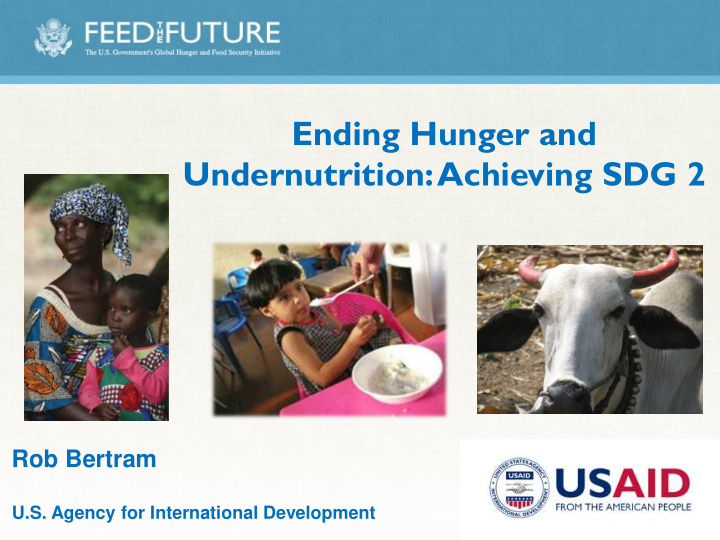



Ending Hunger and Undernutrition: Achieving SDG 2 Rob Bertram U.S. Agency for International Development
Progress and Commitment • Rates of hunger and poverty declining • Agriculture-Nutrition linkages • Stunting rates coming down, but still high • Global Commitment in SDG 2 • Global Food Security Act signals US support
Poverty and hunger declining –but Africa lags Prevalence of poverty (US $1.25/day, 2005 PPP), (%) Prevalence of undernourishment (%) 100 40 East Asia South Asia 1990-92 80 SSA World 2012-14 30 60 20 40 10 20 0 0 World Africa Asia Pacific LAC 1981 1984 1987 1990 1993 1996 1999 2002 2005 2008 2011 Source: PovCalNet 2015 Source: FAO 2015 Hidden Hunger Index (micronutrient deficiencies) Source: Muthayya et al. 2015
The Global Challenge About 870 million people suffer from chronic hunger More than 3.5 million children die from undernutrition each year The world’s population will increase to more than 9 billion by 2050 Food production will have to increase by 60% by 2050 to feed the world Agricultural production will be significantly impacted by climate change
Food Security Innovation: Research 3 Major Research Programs Program anchoring research in key farming systems Integrated Program for Policy Program for Nutritious Cross- Research and Support and Safe Foods Cutting Programs Program for Human and Institutional Capacity Building 19 5
Global Food Security Act of 2016 Building on Feed the Future Success • July 2016 enactment of the Global Food Security Act (GFSA) of 2016 • Passed with broad bipartisan majority • Institutionalized the Feed the Future approach to improving food security and nutrition • Required a whole-of-government, five-year Global Food Security Strategy
New Results Framework 2017 to 2021
What Works to Reduce Undernutrition? • Nutrition-specific interventions are those that address the immediate causes of undernutrition – Health Status – Nutrient Intake • Examples – Infant and Young Child Feed Practices/ENA – Micronutrient fortification/supplementation: Iron, Zinc, Vit. A – Integrated Management of Child Illness – Community Management of Acute Malnutrition 8
Contribution of Different Sectors to Improving Nutrition Globally Water & Food: 32% Sanitation: 35% Women’s Education + status: 33% 116 developing countries (1970-2010) Source: Smith and Haddad, 2013 Marie Ruel, IFPRI
Nutrition-Sensitive Agriculture Target production of nutrient-rich foods, ideally those that include nutrients lacking in diet Include behavior change communication component specifically aimed at consumption of target crops Ensure target food availability and affordability in local markets and support consumption education Measure outcomes, including intermediate targets such as consumption and market availability 10
Adaptation: We must first adapt to existing climate variability The previous El Niño 35 caused billion USD in global economic losses By the end of 2016 40 an estimated million people were expected to be food insecure in southern Africa
Climate Varies Over Time: Which variation is most important? (Precip) Example: Observed Annual Rainfall in the Last 100 Years Trend (“Climate Change”) Interannual (year to year) 5 – 10% 60 – 90% 10 – 35% Decadal http://iridl.ldeo.columbia.edu/maproom/Global/Time_Scales/
Sahel: Annual Precipitation Example: Annual Precipitation over the Sahel 700 650 55% of total Observed 600 I nterannual Variability 290mm from one year to next 550 Rainfall (mm) 500 Decadal Variability 450 250mm in 20 years 400 27% of total 350 “Climate Change” 180mm in 100 years 300 250 18% of total 200 1900 1920 1940 1960 1980 2000 Walter E. Baethgen 2014
Stress Tolerant Maize during El Niño SC513 CZH132018 Murewa, Zimbabwe Peter Setimela
Conservation agriculture (CA) systems during El Niño ume 2 t ha -1 yield benefit of conservation agriculture in Malawi Drought tolerant varieties make better use of residual soil moisture
Rhoda Mang’anya supports 7 people on ~1/2 ha. Today she uses improved maize varieties and fertilizers, but only because of what else she does.
“ I started keeping pigs and goats to support my children in school…and buying of salt, sugar, soap, relish.”
Resilient, diversified production systems Doubled-up pigeon pea/ legume rotation Resilient legumes = more biomass = resilient soils = higher, more reliable yields Ollenburger and Snapp, 2015 Years after establishment
Frontier technologies Addressing infectious diseases in animals • Improve livestock management • Breed resistant animals – New genomics tools • Develop vaccines – Thermostable for improved transport
We have to intensify agriculture, but sustainably • The challenge is to achieve sustainable transformation via smallholder farmers • Existing and future technologies are essential • Farmer choice—seeds, fertilizer, breeds • Resource-use efficiency (water, fertilizer, fuel) • Context for technology scale-up is crucial • Integration of multiple technologies is needed • Information—weather, market, extension • Reduce risk—catalyze investment at all levels
Please See our Feed the Future Website Thank You! www.feedthefuture.gov
Recommend
More recommend